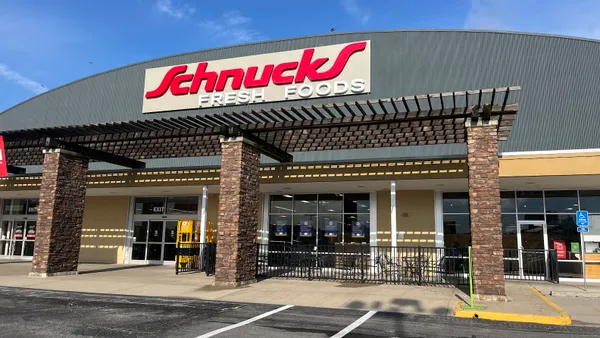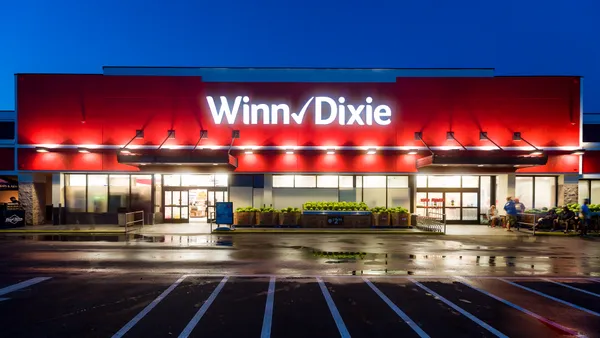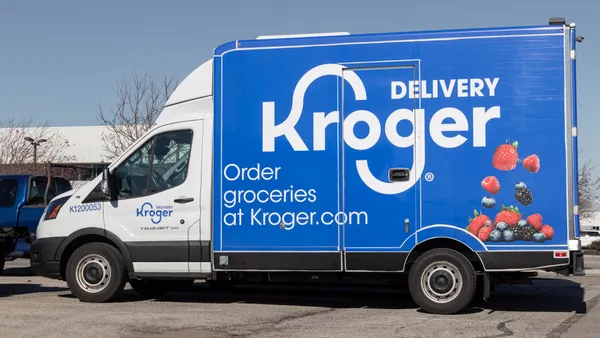Dive Brief:
- Grocery Outlet recorded strong financial results for the first quarter of 2020, as the discount supermarket chain saw sales rise sharply, to $760.3 million, and net income more than tripled. Comparable store sales grew 17.4% year-over-year during the period, driven in part by the company’s addition of 32 net new stores to its fleet since the end of the first quarter of 2019. Grocery Outlet now has 355 stores.
- The grocer plans to open new stores at a 10% annual unit growth rate, the same rate as company officials articulated before the pandemic began. Grocery Outlet has so far opened 10 new stores and closed two in 2020, and is on track to open a total of between 28 and 30 stores this year, CEO Eric Lindberg said Monday during a conference call with analysts.
- The company has continued to see strong sales growth during the second quarter, as customers are spending more per trip even as store traffic remains lower than normal, CFO Charles Bracher said during the call. “We have been actively purchasing and receiving product in response to customer demand and have now rebuilt to a healthy inventory position in our stores and warehouses,” he said.
Dive Insight:
Grocery Outlet’s value-oriented business model appears to be paying dividends as the supermarket chain manages its way through the pandemic and looks to position itself for growth as the economy begins to reopen.
The difficulty traditional supermarkets have been having as they strive to keep stores consistently stocked with products has played into the hands of Grocery Outlet, which specializes in attracting buyers with bargain prices as opposed to a predictable assortment of goods, a concept it refers to as a “treasure hunt.”
“Manufacturers have dramatically increased production and they’re actively making production line SKU assortment and packaging changes,” said R.J. Sheedy, president of Grocery Outlet. “The imbalances between supply and demand have and will continue to occur. We have already begun to benefit from some of these imbalances and we expect to see more opportunities in the future.”
Grocery Outlet’s focus on selling merchandise it acquires at discounted prices has put it in a strong position as shoppers are looking to save money during record unemployment and financial uncertainty. Meanwhile, demand from restaurants, department stores, airlines, airports and other traditional customers has cratered because of the pandemic. Grocery Outlet is well-positioned to repackage items that are not “retail-ready” and make them available to its customers, Sheedy said.
“We continue to see healthy opportunistic deal flow from our existing suppliers," Sheedy said. "These offers are for products that span all categories including some of those experiencing the highest consumer demand. We’ve also been contacted by many new suppliers that need to move through product as their distribution outlets have closed or are experiencing significant sales declines." He added that the company, which went public last year, expects to maintain those relationships over the long term.
Sheedy said Grocery Outlet remains cool to e-commerce, although it has continued to test online shopping in a small number of stores as a service to customers who don’t feel visiting stores in person, he said. He declined to say how the company would proceed. “We’ll keep a close eye on that and see how it evolves, but we would describe it very much as pilot stage right now,” he said.
As it looks to grow, Grocery Outlet will be looking to strike favorable terms with landlords who may have been adversely impacted by the retail closures brought on by the nation’s response to the pandemic, Lindberg indicated. “It’s possible and I think it’s likely that we’re going to see some better real estate opportunities coming later in the year [or the] beginning of next year," Lindberg said. "I think patience will pay off; a lot of landlords are not going to be quick to recognize that return should be lower."









